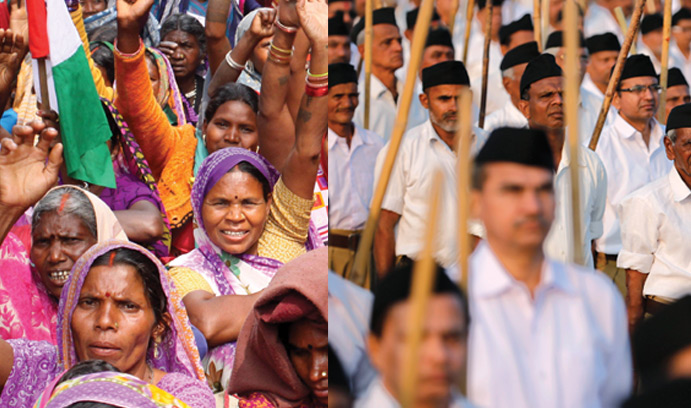Mobilizing Social Movements

Success for a social movement, says Nandini Deo, who studies feminism and Hindu nationalism in India, depends less on its ideology than on its ability to mobilize grassroots support. (Photos courtesy of Corbis Images by Arun Panwar and Amit Dave)
Nandini Deo has spent the past 10 years studying social movements in her native country of India. She started with the women’s movement for equal status. “If I hadn’t become a political scientist, I think I would have become a full time activist in the women’s movement. It makes sense to me,” says Deo, who has been at Lehigh for the past seven years.
This winter, Routledge is publishing Mobilizing Religion and Gender in India, a book by Deo that explores the effectiveness of feminism as a social movement with roots that stretch at least to the beginning of the 20th century.
Her overall goal was to understand what makes social movements work. “How do a group of activists with an ideological commitment translate their deeply held ideas into something that others also come to support? That’s the big question I’m asking,” she says.
Her examination of feminism in India began with trying to understand how activists influence policy. “But they’re actually not very successful in doing that. The question is, why? I wondered if there was more the women's movement could be doing. I thought it was useful to have a comparative case,” she says.
Deo, associate professor of political science, chose to study the Hindu Nationalist political movement alongside the women’s movement during the same 20th century time period. The political movement also had a defining set of ideals. “I tried to identify times when both movements were very successful and times when they were less successful. Then I tried to connect those particular instances to strategies that activists were using,” she says.
While examining the women’s movement, Deo found that it stagnated at times when there was very little coordination among the various groups involved. They did not have a coherent lobbying voice to lead them. The Hindu Nationalists, on the other hand, had a more organized method that led to successful action.
Besides having to contend with opposition from the status quo, social movements are pulled in different directions by a myriad of external influences, including economic, political and social. Deo parsed through the complex factors surrounding the evolution of both the Hindu Nationalist and the feminist movements.
She concluded that a social movement’s fluctuations between success and failure don’t depend on its ideology. Instead, a movement’s ability to effect change through the decades depends on how well its members seize opportunities to build trust and mobilize support from the grassroots.
When she was interviewing activists in the women’s movement, Deo was surprised to encounter only one instance of someone asking her to help the cause by inviting her to join a protest or raise some money.
“There was no attempt to pull me in. Yet, when I researched the Hindu Nationalists, almost every time I interviewed someone, they asked me to help,” she says. Since Deo disagreed with their goals, she didn’t participate. “It was striking to me that there was this difference. It speaks to one of the really important differences between the two movements. The feminist movement has become professionalized to a large extent, so it’s not as savvy about how to recruit new activists,” she says.
In other words, while women’s movement supporters feel strongly about equal status, they are not as proactive about creating new ways to keep pushing for their goals.
When Indian Prime Minister Indira Gandhi declared a national state of emergency in the 1970s in response to political and economic unrest, many civic groups, including women’s organizations rejected working with what they saw as a corrupt and undemocratic state.
“Many of the groups that had been very well mobilized found their activists imprisoned. They were disillusioned by that, so they turned away from working with governments and got support from foundations and transnational agencies instead,” Deo says.
However, those agencies have since increasingly chosen to throw their energies behind various non-governmental organizations (NGOs), resulting in fewer resources and support for still struggling women’s groups. “I say that the women’s movement would have done better staying connected with the government in the long run,” says Deo. Meanwhile, the Hindu Nationalists were able to take advantage of the Emergency, as it came to be called. They used it as an opportunity to re-energize their constituents and their overall organization.
“It was a moment when the establishment was rejected by many people, so the Hindu right seized that moment to make themselves part of the bigger picture again,” Deo says.
That’s not to say that the women’s movement in India is finished. No social movement develops in linear fashion. Enthusiasm may dwindle, but it can also flare up again and effect real changes in a society’s culture.
Over a century of social activism, the individuals involved can always make choices that will lead to their goals, Deo says. “Activists have lot of control over their own future. What they do today will lead to consequences 10, 20, 30 years from now. I don’t think the future of either movement, the women’s movement or the Hindu Nationalists, is set in stone. It’s really very much open.”
For Hindu Nationalists, gaining control of the state seems to have been a smart strategy. “The emphasis on education and building schools has really paid off. The women’s movement has moved away from an education emphasis, but it could always get more involved that way,” Deo says.
She has seen feminists take some recent steps towards success. “A lot of feminists actually are becoming more creative about fundraising, which is a really positive sign and likely to revitalize the movement, as they are able to reach out to local supporters more,” she says.
While her studies and findings are written for a scholarly audience, Deo hopes Mobilizing Religion and Gender in India is accessible and clear enough to appeal to the public as well.
Over the past six months, Deo has begun work on a new project, spurred by the Indian government’s passage of the Companies Act, which lays out rules for corporations. She’s interested in the directive that all companies of a certain size must set aside 2 percent of their annual profits for charitable causes. Deo is looking at which charitable causes are getting that money and how they are using it. June 2015 rang in the end of the first fiscal year under the new act, so Deo took a team of students to India this summer to gather initial data about corporate donations.
“One of the arguments I make about the problem with the women's movement is that they were too dependent on external funds. If this corporate money is made available to them, I’d like to know what impact it may have on their work and what they will do with it,” she says.
Story by Manasee Wagh ’00
Posted on:


